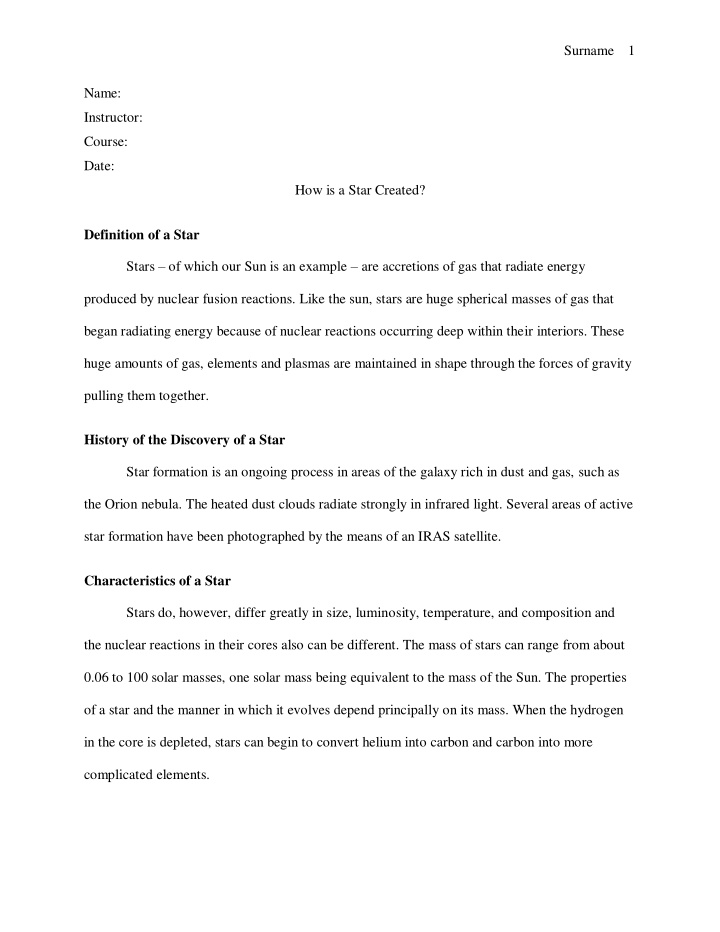



Surname 1 Name: Instructor: Course: Date: How is a Star Created? Definition of a Star Stars – of which our Sun is an example – are accretions of gas that radiate energy produced by nuclear fusion reactions. Like the sun, stars are huge spherical masses of gas that began radiating energy because of nuclear reactions occurring deep within their interiors. These huge amounts of gas, elements and plasmas are maintained in shape through the forces of gravity pulling them together. History of the Discovery of a Star Star formation is an ongoing process in areas of the galaxy rich in dust and gas, such as the Orion nebula. The heated dust clouds radiate strongly in infrared light. Several areas of active star formation have been photographed by the means of an IRAS satellite. Characteristics of a Star Stars do, however, differ greatly in size, luminosity, temperature, and composition and the nuclear reactions in their cores also can be different. The mass of stars can range from about 0.06 to 100 solar masses, one solar mass being equivalent to the mass of the Sun. The properties of a star and the manner in which it evolves depend principally on its mass. When the hydrogen in the core is depleted, stars can begin to convert helium into carbon and carbon into more complicated elements.
Surname 2 Creation of Stars Figure 1. The Diagram of a Star’s Development, Part 1. Figure 2. The Diagram of a Star’s Development, Part 2. Structure and Development Stars Stars begin their lives through the gravitational contraction of clouds of gas and dust called nebulae. The collapsing mass heats up because the pressure increases. This concept is
Surname 3 exactly he same process that heats up the air in a bicycle pump when it is being used. After a while the mass of the gas becomes spherical and glows red: a protostar is formed. As gravitational contraction continues, the confined temperature and pressure at the center of the gaseous mass initiates the nuclear reactions that supply the energy of a fully formed star. Protostars continue to collapse, they become denser and hotter. Eventually, they may become hot enough for nuclear fusion reactions to start and thus turn to fully developed star. A balance between the exterior and interior core of the star presents it from collapsing. This is achieved through a process of radiation and convection starting from the core going to the exterior region of the star. Pre-Test Questions: 1. What are stars made of? 2. What do you call the clouds of dust and gas that forms a star? 3. Give the name of the most famous star. Answers to Pre-Test Questions: 1. Stars are made up of gasses & elements 2. Nebulae 3. Sun or Helios in Greek Post-Test Questions: 1. What do you call a star that is at its youngest/earliest developing stage? 2. Give three critical requirements for the formation of stars?
Surname 4 Answers to Post-Test Questions: 1. Protostar 2. Pressure, Gravity, and Temperature
Surname 5 Works Cited Bogawain, Bobie. Stars and Galaxies. Esquire. 1988. Grasshoff, Gerd. The History of Ptolemy's Star Catalogue . New York: Springer. 1990.
Recommend
More recommend